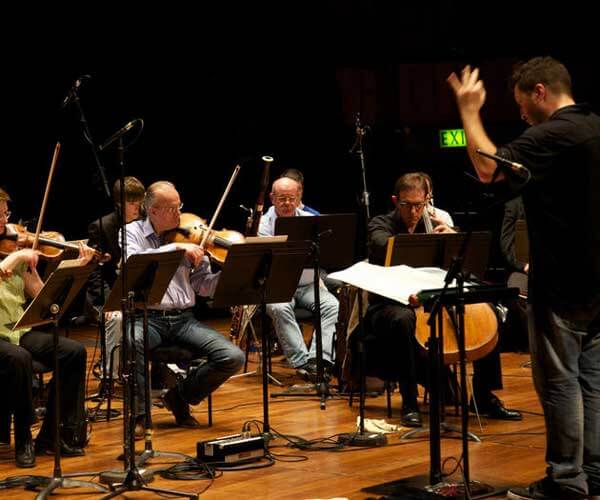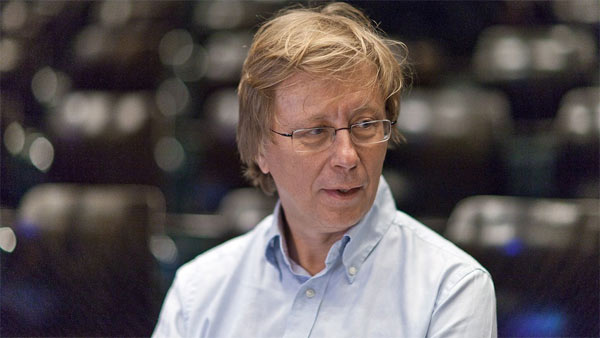 On Friday, December 7, London Sinfonietta descended into pre-natal darkness in a spectacular rendition of Georg Friedrich Haas’ masterpiece in vain (2000) at the Queen Elizabeth Hall in London.
On Friday, December 7, London Sinfonietta descended into pre-natal darkness in a spectacular rendition of Georg Friedrich Haas’ masterpiece in vain (2000) at the Queen Elizabeth Hall in London.

London Sinfonietta
Although written in response to the rise of the right wing in Austria, the work does not necessarily function as a political statement. The concert-length piece felt more like a psychoacoustic articulation of the elastic and changing experiences of time, timbre, varying pulses, microtonal tunings and harmonic spectra. In a British health-and-safety regulation officer’s nightmare, the score calls for the auditorium lights to be dimmed to total blackout for two extended sections in artificial sunsets and sunrises, punctuated with surreal pulsing flares and creating extraordinary situations of heightened awareness. The performers are required to remember instructions and proceed by ear and feel during the blackouts, listening to each other while abandoning visual communication with their instruments, the conductor, each other and the audience. Haas involves the spectator as an involuntary participant, literally robbing one of sight and forcefully focussing attention on the sound. Not knowing what to expect, we drifted blindly through spatially-disjointed movements of color and shimmering timbral interplay between instruments, shocked into abrupt changes of state with surprising punctuations of sonorities and at times violent visual stimuli.
During the pre-concert talk Haas reflected on growing up near a power station and being fascinated by the sounds of electricity. The “overtone” chords of humming machinery in the hospital would have been the first sounds heard by the composer (and many of us) at birth, possibly influencing his fascination with the overtone series. Demonstrating harmonic constructions at the piano, Haas still humbly insisted that the mechanics of tonal systems should not be of interest to the audience. While Haas thinks about his answers, he takes time – unusually long periods of “dead air” that might make radio presenters writhe with discomfort, but something he appears to be comfortable doing. The hall remained silent and still during these moments, waiting with uncanny attention.

Georg Friedrich Haas
The Sinfonietta are to be congratulated for their excellent form and dedication to the score. Emilio Pomàrico led the 24 musicians through the conducted sections with flexibility, sincerity and uncompromising commitment. The ensemble created a rare cohesion between the soloistic demands of the individual parts and broader organic textures meant to blend and cross-fade resonances of the instruments. While every musician deserves a mention, particularly notable were the crisp and precise articulations from harpist Manon Morris, the understated virtuosity of pianist John Constable, and wide-ranging color palettes of percussionists David Hockins and Toby Kearney. Equally notable were accordionist Ian Watson in an intense and demanding part and the string section led by violinist Alexandra Wood (with impressive cello work by Richard Lester and Zoe Martlew), as well as the excellent brass section.
The light choreography has to be experienced in order to fully appreciate the rhythmic detail of the score. Haas’ instrumentation is a rich exploration of timbre, with formal and rhythmic proportions flawlessly balanced. In addition to the influences of “spectral” techniques, Haas finds a highly original voice, seemingly achieving a balance between rigorously systematic and perhaps more intuitive approaches. The use of silences is particularly effective, and the music crosses beyond individual personality and technique into strange realms of universal experiences, bending and warping awareness of psychological time-flow. The seventy minutes of the concert did not appear to be subjectively “in”-time, but rather presented a series of time-stretched changes. We were all sharing something, yet separate; intensely present, yet forgetting who and where we were. It felt almost artificial to be jolted into reenactment of traditional roles after the sudden cut of the end, launching into a long ovation and post-concert chatter. Lingering on just beyond reach, there remained a strange taste of something important we did not quite understand, like a fading afterglow.






















